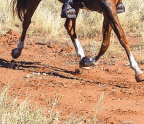A UNIQUELY EXCELLENT AMERICAN CREATION

The deep roots of the American Saddlebred extend to the founding of the Thirteen Colonies. The Saddlebred shares its 18th and early 19th century gene pool with its sister breeds the Standardbred and Quarter Horse, whose histories have already been covered in previous series.
Saddlebreds are capable of numerous gaits involving either lateral or diagonal coordination, and many individuals are as appropriate and attractive in light harness as they are under saddle. Historically they were full-bodied horses possessed of almost incredible stamina and soundness, and they were counted among the world’s beautiful horses. Let us begin the fascinating story of the Saddlebred, a uniquely excellent American creation, by considering the momentous events of a particular Sunday morning in the spring of 1865….
WITH MALICE TOWARD NONE
Exhausted and disheartened, Confederate General Robert E. Lee arose after a sleepless night and dressed himself in ceremonial white uniform, complete with sash and golden saber. The day before, Union forces had surrounded the Army of Northern Virginia and cut them off from supply lines, conscripting the last wagonloads of food intended for the starving rebel army. In face of these realities Lee at last conceded defeat, saying “there is nothing left for me to do but to go and see General Grant.” A meeting was duly arranged for Sunday, April 9th in the nearby village of Appomattox Court House, and it was for this that Lee dressed himself in his finest.
INFLUENCES AND ORIGINS

This chart summarizes entries in the first five volumes of the Saddlebred Registry. In round numbers, only about 0.6% of the horses are pure Thoroughbred, while others vary from 50% down to 3% (one-sixteenth-bred).

This map shows trade routes during the Colonial era. Chicasaw villages are marked by large red circles.
Grant, meanwhile, had also been up all night---reconnoitering on horseback, meeting with troops and commanders, making sure the Union line would hold. He arrived for the surrender ceremony wearing a dusty army-issue sack coat devoid of insignia except for the tarnished golden epaulettes that revealed his rank. Mud-spattered trousers tucked into the tops of scruffy high-top boots completed his outfit. Accompanied by several staff officers, Grant bore no sword or sidearm.
Appearances can be deceiving; it was the man in worn and dirty clothing who was the victor in the bloodiest conflict in American history. Lee expected that surrender would be humiliating and severely punishing, but Grant’s terms---in accordance with the wishes of President Abraham Lincoln---were generous. In return for turning in all major weapons and pledging to never to take up arms against the U.S. government again, some 28,000 Confederate soldiers were given food and allowed to return home. Confederate officers who surrendered were generally not prosecuted although Lee and others were eventually fined. Officers were allowed to keep their side arms and their horses. Most significantly for the history of American horse breeding in the South, ordinary soldiers, too, were allowed to ride their own horses and mules home so theywould be able to complete the spring planting.
DISTINCT, MONUMENTAL, AMERICAN ACHIEVEMENT
It is often stated that the American Saddlebred represents a blend of two families: The Denmarks (sire-line descendants of Denmark 1839 through his son Gaines’ Denmark 1851) and the Chiefs (descendants of Harrison Chief, foaled in 1872). Blending of the two lines was intensive in Kentucky and Missouri during the last 25years of the 19th century and the first decade of the 20th, and without question it was the melding of these two families that produced the Saddlebred horse as we know it today. There were, however, several earlier strains which made important contributions, and these had their origins in colonial Virginia, Maryland, Vermont, Mississippi and South Carolina, and even as far away from Kentucky as Texas and Canada.
Before the Civil War, the American South had been famous for its saddle horses. English Thoroughbreds imported to the American colonies were the highly sought-after topcross in Southern horse breeding,
You’re reading a preview, subscribe to read more.
Start your free 30 days



